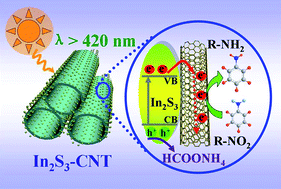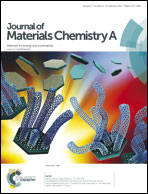Synthesis of In2S3–CNT nanocomposites for selective reduction under visible light
Abstract
In2S3–carbon nanotube (In2S3–CNT) nanocomposites have been prepared via a facile refluxing wet chemistry process. The as-synthesized In2S3–CNT nanocomposites can be used as selective and active visible-light-driven photocatalysts toward hydrogenation of nitroaromatics to amines in water. Photoirradiation (λ > 420 nm) of In2S3–CNT photocatalysts suspended in water containing nitroaromatics produces the corresponding amines with high yields. The control experiments reveal that an inert atmosphere and the addition of a hole scavenger are both indispensable for the visible-light-driven photocatalytic hydrogenation of nitroaromatics over In2S3–CNT. In comparison with blank In2S3, the obviously enhanced photocatalytic performance of the In2S3–CNT photocatalyst is mainly ascribed to the unique physicochemical properties of CNTs, which enhances the adsorptivity of the substrate and performs as an electron reservoir to trap electrons, thereby hindering the recombination of photogenerated electron–hole pairs. It is hoped that the current work on the facile synthesis of semiconductor In2S3–CNT nanocomposites can broaden the applications of semiconductor-carbon based composite photocatalysts in the field of photocatalytic selective organic transformations under mild conditions.


 Please wait while we load your content...
Please wait while we load your content...